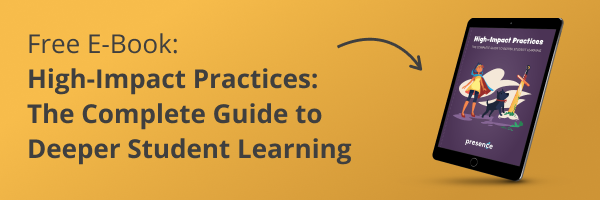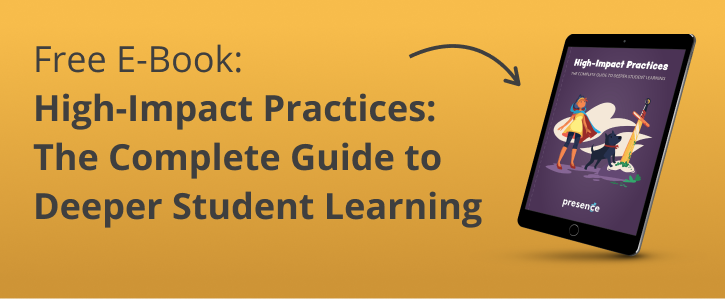As student affairs professionals, we know better than anyone that high-impact practices (AKA HIPs) support student success and retention, plus have long-term personal and professional benefits.
But how many of your students are saying, “I need to participate in one of these high-impact practices during my time here on campus?” Unless you are mentoring them to become a or higher ed professional themself, probably not too many! Chances are that most students’ participation in a high-impact practice occurred by happenstance.
So, given the proven benefits of HIPs, how can we better educate our students on them and encourage participation? There are two simple answers: recruitment and retention!
Yes, that sounds pretty generic. And when we hear the word “recruitment” we often think “that’s admissions’ job!” But after admitting great students into our institutions, we must recruit them for meaningful co-curricular opportunities to keep them retained and to contribute to their success now and in the future. Specifically, we need to recruit them to engage in HIPs.

Here are five smart strategies for doing so:
5 Strategies
1. Reframe your recruitment pitch through assessment
There are so many great HIPs out there that have been proven to boost student outcomes. So, it may seem like a good idea to incorporate them all at your institution. But I strongly advise you to not do that. In fact, the first step in recruiting students to participate in HIPs is to identify the ones that your campus already does really well and run with them.
When you are encouraging a student to engage with any HIP, you need to be able to guarantee that they will be supported within the program. So, first off, you need to take an honest look at your HIPs and design a fitting recruitment message. Don’t just boast about generic benefits of HIPs; tell students how this looks for your student body specifically and for each individual HIP experience.
Here’s a great example from the College of Saint Benedict/Saint John’s University’s Undergraduate Research & Creative Work Program:
“Undergraduate Research is here to help you maximize what you are learning in your courses by applying your new knowledge and interests to the out-of-the-classroom, hands-on experience of research. Our opportunities are open to any major, at any point in their college career. And we guarantee you will be supported with high-quality one-on-one faculty mentorship, personalized advisement from full-time staff, and financial investment through our many grants and fellowships.
It is because of this support that we have 1 in 4 (or 900+) students participating in research each academic year, with many students completing numerous research experiences prior to graduation. Over 96% of student participants reported that they have grown as a scholar, further developed problem-solving and innovative thinking skills, and feel comfortable taking initiative in new situations.
With significant research experience on their resumes, our students have gone on to top-notch graduate programs such as the University of MN Medical School or London School of Economics & Political Science, become winners of prestigious awards such as the Truman Scholarship or Fulbright Award, and gained employment with impressive organizations, such as the US State Department and the CDC.”
Why does this recruitment pitch work so well? Simply put, it is student-centered and outcome-focused. It outlines varying levels of financial and operational support available to students, provides real-life data on student participation, mentions accessibility at various points in their academic career, and details impressive student feedback that leads to long-term results post-graduation.
Through this framing, a student can start to visualize themself participating and benefiting from your program at your institution; making it clear that while they might be able to do research anywhere, they will be most successful doing research here with you.
If you work in student activities or co-curricular engagement, then you may be able to conduct a campus-wide assessment of HIP impact and engagement. Or maybe you’re currently coordinating a HIP that’s producing great learning outcomes and high student satisfaction.
Either way, ask these simple reflection questions to help you design your new recruitment campaign:
- What types of personnel or structural support does my HIP have?
- What types of financial resources are available for students participating in my HIP?
- How many students are participating in each of these HIPs?
- What types of students are participating? (For example, is it mostly first-year students? Residential students? STEM majors? Honors students?) What types of students are not participating?
- What does success look like for students that participate in this HIP?
If you reflect on those questions and don’t like what the answers reveal about the quality of your HIP, then you may not actually be ready to recruit students; rather, you may need to go back to the program development phase to make it a stronger program to begin with.
2. Send the message that academic planning must include HIPs
Your second step should be to help students plan. It is one thing to recruit students and tell them all the good things a HIP has to offer them, but we need to also follow through and secure their engagement by helping them visualize how HIPs can fit into their academic plans.
From basic pen and paper techniques to using game-changing co-curricular tools like Presence’s SmartTranscript, teach your students how to map out a semester-by-semester plan leading up to their graduation date. Start with courses, and then ask them to think about when engaging in research, study abroad, an internship, or another HIP might fit into the picture.
By encouraging students to consider and plan for possibilities early on, you can empower them to take full control of their own learning experiences, leading to even greater investment and satisfaction on their end!
Where and when can this academic and HIP planning take place? Beyond your own office, here are a few suggestions:
- If your campus offers or requires first-year seminar courses (a type of HIP in itself), consider including an assignment or exercise wherein students develop an academic plan that identifies HIPs they’d like to participate in and when.
- Learning Communities are another type of HIP and are also excellent venues for academic and HIP-planning exercises. Students in learning communities typically have common interests and goals and may all naturally gravitate toward the same HIPs. Group planning exercises like this are also great ways to facilitate dialogue around the value of participating in HIPs.
- If your institution has a large physical footprint or has several campuses, consider taking your HIP planning on the move through kiosks or pop-ups. Make a room reservation for a meeting space in your library, in academic buildings, or even in your campus recreation center to make HIP information, planning, and resources more accessible to students who might not make it to your own office.
- Now that we are all a bit more comfortable in virtual spaces, offering HIP planning sessions via video call is an excellent option for students who have busy course schedules, work during the day, or are only on campus for evening classes. You could offer one-on-one appointments for students who would like personalized support or you could offer group sessions for students who might have an interest in the same HIPs. Virtual HIP planning sessions allow for flexible scheduling, improving accessibility to HIP info and advising.
Now, you may be thinking, “who is actually going to assist students with the planning in these spaces?” Perhaps you feel that you can’t ask academic advisors or faculty members to take on this responsibility on top of everything else these folks already do.
Well, let’s talk about this seeming conundrum in step 3.
3. Incorporate peer involvement coaches
One of the easiest ways to prove the value of HIPs is to let students hear it from their peers. If your office already employs students to help with operations and programming, then congrats — you have a framework to start with incorporating peer involvement coaches!
The University of Michigan utilizes Involvement Peer Advisors to help connect students with co-curricular opportunities like HIPs. Students can schedule a 30-minute appointment with a peer advisor to discuss different ways to get involved on campus based on their academic and personal interests.
Your peer involvement coaches could share their own personal experiences participating in HIPs and serve as ambassadors for recruitment. Peer involvement coaches can also give presentations in first-year classrooms, informing students of how to apply or sign up for HIPs. Furthermore, these student leaders can help their peers map out four-year experiential plans that include research, internships, study abroad trips, and other HIPs.
4. Provide financial or structural support
It is unrealistic (and unhealthy) to expect students to sacrifice their basic needs or ignore other responsibilities in order to participate in HIPs.
We know that many students cannot afford to do unpaid work, meaning that internships and research projects may not be feasible HIPs for them. They need to work over the summer or part-time during the academic year to pay for their education or support their families.
Therefore, establishing scholarships and fellowships to support students pursuing HIPs is not only a smart way to recruit students but also allows you to increase access to HIPs — especially for student populations that have historically been underrepresented in co-curricular programming. For example, my institution, the College of Saint Benedict/Saint John’s University, established a paid fellowship program for students serving in unpaid public service internships each summer.
Similarly, students might simply be too busy to add another thing to their plates. So, you can help recruit students into HIPs by helping them find reasonable ways to work the experience into their schedules.
For example, if you are advising a student who cannot afford to miss their work-study position for a full semester, you might be able to connect them to a course that has a short-term study abroad program embedded in it. That way, the student will only be away from campus for two weeks and still be able to participate in a HIP while staying employed.
5. Showcase success
When I say “marketing,” you’re probably thinking of writing social media posts, publishing news articles, or even filming commercials. But, here, I’m actually talking about the ability of our students to market their HIP experience for their own personal and professional benefits.
The final step in recruiting a student for HIPs involves communicating the support that will be available after the HIP officially ends. Let them know that you are going to support them in bringing that experience to the job market, to their grad school interviews, and beyond.
To follow up on that promise, partner with your career center to develop post-HIP workshops. The purpose of these sessions is to help students reflect on the skills and knowledge developed. The workshops should also walk students through mock interviews, elevator pitches, and personal statements. The goal is for students to walk away knowing exactly how to talk about their high-impact experience and market it in a professional setting. Perhaps they could even pay it forward by recommending the experience to their peers!
And, as an added bonus for you as an SApro, you will get to hear students talk about their personal and professional growth through those co-curricular experiences that you care so deeply about. It’s a win-win!
The five strategies I outline are centered on providing comprehensive, holistic support for students from the start of their HIP to the finish.
I also want to make clear that these strategies are not meant to be a one-and-done exercise.
Rather, these five steps are designed to be more cyclical and repeated, in order to encourage students to pursue more than one HIP during their time on campus.
What is the ultimate outcome of practicing and repeating these 5 strategies on your campus? The hope is that whenever a student completes a HIP, that they will be even more excited about pursuing another because they know that they’ll be encouraged and supported every step of the way.

How have you recruited students to participate in HIPs? We’d love to hear your ideas! Connect with us on Twitter @themoderncampus and @lindseyggutsch.





